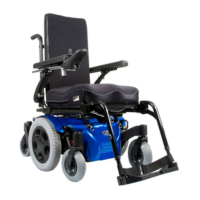103688 Rev. A
6
QUICKIE PULSE
V.
WARNING
Individuals with physical limitations requiring the use of
a specialty control input device known not to be
immune to 20V/m, or not known, should exercise extra
care around known sources of EMI.
WARNING
There is no way to know the effect on EMI if you add
accessories or modify this chair. Any change to your
chair may increase the risk of EMI. Parts from other
suppliers have unknown EMI properties.
F. REPORT ALL SUSPECTED EMI INCI-
DENTS
WARNING
You should promptly report any unintended movement
or brake release. Be sure to indicate whether there was
a radio wave source near your chair at the time.
Contact: Sunrise Medical Customer Service
Department at (800) 333-4000.
3. Long-Range Transceivers:
These include commercial radio and TV broadcast antenna towers
and amateur (HAM) radios. Note: The following are not likely to
cause EMI problems: Lap-top computers (without phone or fax),
Cordless phones, TV sets or AM/FM radios, CD or tape players.
D. DISTANCE FROM THE SOURCE
WARNING
EM energy rapidly becomes more intense as you get
closer to the source. For this reason, EMI from hand-
h
eld devices is of special concern. (See C.1 above) A
person using one of these devices can bring high levels
of EM energy very close to your chair without you
knowing it.
E. IMMUNITY LEVEL
WARNING
1. The level of EM energy is measured in volts per meter (V/m).
Every power wheelchair can resist EMI up to a certain level.
This is called its “immunity level”.
2. The higher the immunity level, the less the risk of EMI. It is
believed that a 20 V/m immunity level will protect the power
wheelchair user from the more common sources of radio
waves.
3. The Quickie Pulse with the following configuration was test-
ed and found to be immune to at least 20 V/m:
Quickie Pulse power wheelchair with a right-hand mounted
RNET controller, A.S.A.P. seat, flip-back armrests, solid flip-
up footplate and Group 22 batteries.
4. The following specialty input devices have an unknown effect on
the immunity level because they have not been tested with the
Quickie Pulse and RNET control system:
• Breath Control
• Proportional Head
Control
• Tri-Switch Head Array
• Proportional Mini-
Joystick/Chin Control
• Heavy Duty Switched
Joystick
• Buddy Button
• Treadle Switch
• Micro Light
• Ribbon Switch
• Star Board
• Proximity Head Array
• Wafer Board
• Zero Touch Switch
• Penta Switch
• 4-Zero Touch Switch
• Plate Switch
• 5-Zero Touch Switch
• Soft Switch
• Disc Switch
• Grasp Switch
• Wobble Switch

